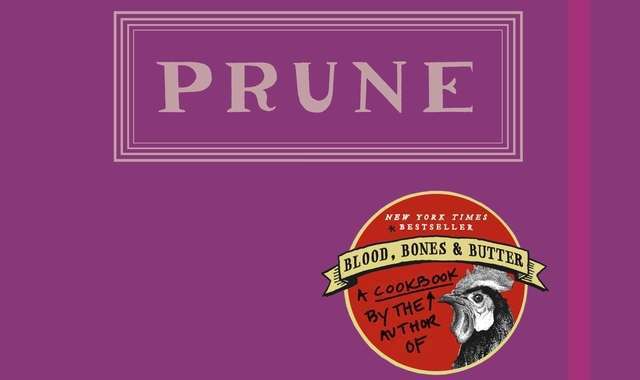By Sofia Perez
[Published by Zester Daily, December 31, 2014]

Chef Gabrielle Hamilton and Sofia Perez
“Don’t use anything better — no brioche! no pain de mie! — in some attempt to make this ‘gourmet.’ We are not that kind of restaurant.” –Gabrielle Hamilton, in Prune (Random House, 2014).
It’s not every day a James Beard Award-winning chef wields the word “gourmet” as a barb, or exhorts you to use Pepperidge Farm bread instead of fancier alternatives, but Gabrielle Hamilton is not your average high-profile chef. Since 1999, when she opened Prune, her tiny restaurant in New York City’s East Village, she’s gone her own way, and the same can be said of her first cookbook, Prune.
A companion piece to Blood, Bones & Butter, her critically acclaimed memoir, Prune deftly captures Hamilton’s personality as well as that of the restaurant, neither of which are easy to pigeonhole. She’s a self-taught chef who has an master’s degree in fiction writing, while Prune is the kind of place where a bar snack of canned sardines with Triscuits confidently holds court on the same menu as “Tongue and Octopus with Salsa Verde and Mimosa’d Egg.”
The cookbook was written as if Hamilton is addressing her staff and has been designed to look like a stylized photocopy of the recipes she types up for their regular use, complete with re-creations of the handwritten notes she pens when she’s forgotten some helpful detail. “If [the braising liquid] tastes too bright,” she scribbles at the end of a lamb recipe, “heavily char—almost burn—2 slabs of peasant bread on the grill…push the burnt toast down into the liquid to soak it … It will add body to the braise and soften the astringency.”
In its earliest days, Prune served only dinner, so that’s where the book begins, too. Tables of contents lead into the various subsections, but there’s no general index (though one will soon be available for download). Instead of lyrical head notes about a dish’s story of origin, Hamilton dives right in to the steps, though her voice is unmistakable when she directs you to “fully enclose the butter inside the dough, as if you were hastily wrapping a Christmas present.”
When I visited her at Prune recently, she explained the thinking behind the book’s form and content. “I tried writing it the conventional way for about five minutes, and it was immediately clear that I was lying my brains out, because I don’t use that language. The imperative was to tell the truth as I live it and experience it. I knew people would get it.”
The unique structure and tone are not the only things that set the book apart. There’s also a section called “garbage,” which details how the restaurant repurposes oft-discarded items such as zucchini tops and bacon rinds. At a time when Americans throw away nearly 40 percent of the food they buy, this chapter seems especially appropriate.
Prune includes many of the restaurant’s marvelously layered dishes, like “Warm Lentil Salad with Fried Chicken Livers, Poached Egg, and Smoked Tomato Vinaigrette,” as well as directions for assembling the more minimalist offerings (such as a bar snack of radishes with sweet butter and salt) whose unassuming appearance belies the care that underpins them. The first time I ever interviewed Hamilton, five years ago, we discussed the reaction to these “three-ingredient recipes,” a subject we revisited during our recent chat.
“They’re the ones that set you up for failure,” she says, “because there’s nothing to hide behind. Only radishes and butter and salt—what could possibly go wrong? And yet. You have overgrown, cottony, spongy radishes that have soaked in too much water, and they’ve lost their flame. Or the butter is over-tempered and greasy. Or you’re using the worst, overly granulated, way-too-salty salt. But when you have the right crispy-firm, hot-on-fire radish, the cool waxy butter, which not only tempers the heat but lets the salt adhere, and the salt, which brings back the flavor that the butter has started to tame.” She smiles. “I know it’s just three things, but can you believe what goes in to simplicity?”
There’s much to like about Prune, starting with Hamilton’s mouthwatering food, but what’s most appealing is the respect she shows her readers, a quality that took on paramount importance for her after she visited home kitchens during a road trip a couple of years ago. “I had lost track of who we were talking about when we use that phrase ‘for the home cook,’ and it turns out the home cook is incredibly diverse … I think the cookbook industry in the main tends to underestimate them, and it’s time to stop.”
When she directs you to garnish a dish with a “lime cheek,” she trusts you’ll get it, and if not, you can figure it out from the photos. Even when her insider notes are not directly relevant to your kitchen reality, they often get you to reconsider some element of how you prep, cook, serve, or store your food. And at their least practical, the asides to her staff (“If Health Department comes, take the serrano [ham] off the carving stand and throw in the oven”) still offer us a peek behind the scenes, which is one of the reasons people buy chef cookbooks in the first place.
Ultimately, it’s that sense of transparency that remains at the heart of the whole endeavor. “The book is the same as Prune and me in every way,” she tells me. “We’re not to everyone’s taste—our food, our gestalt—and neither is the cookbook. We love you, and we hope you love us, too, but we’re not gonna lie about who we are.”
Farmhouse Chicken Braised in Hard Cider
[Excerpted from Prune by Gabrielle Hamilton. Copyright © 2014 by Gabrielle Hamilton. Excerpted by permission of Random House, A Penguin Random House Company. All rights reserved. No part of this excerpt may be reproduced or reprinted without permission in writing from the publisher.]
Even though it’s best to use homemade chicken stock, I opted for a high-quality low-sodium supermarket brand, which produced good results. If you are using store-bought stock, be sure to factor in the sodium level when seasoning the dish. Since I mistakenly purchased a package of drumsticks instead of whole chicken legs, I cooked a total of eight drumsticks, two per serving. –Sofia
Yield: Makes 4 servings.
Ingredients
4 large whole chicken legs
Unsalted butter
Extra virgin olive oil
¾ cup slivered garlic
1 cup thinly sliced shallots
½ cup cider vinegar
1 cup hard cider
1 tablespoon honey
1 tablespoon tomato paste
1 cup chicken stock
Kosher salt and freshly ground black pepper
Directions
Season chicken legs all over with more pepper than salt.
Brown chicken legs in mixed fats, more butter than oil.
Brown perfectly, on both sides; don’t crowd and don’t crank it, either. Keep heat at medium-high and do a careful job.
Remove chicken, pour off fat.
Add a good hunk of butter, the garlic and shallots to the same pan, reduce heat, and sweat.
Add tomato paste and stir to fully blend, melt, even toast a little.
Deglaze with cider vinegar and hard cider.
Add the honey.
Simmer to cook off alcohol and reduce slightly, by no more than 1/3. Stir in chicken stock.
Neatly nestle the chicken legs in the pan and be sure to taste the braising liquid for salt, acidity, sweetness. Adjust now or never.
Cover with parchment and tight-fitting lid, if you can find one that isn’t too warped. Check after 25 minutes. You want loose joints but not falling off the bone.
At pickup, reduce sauce per portion, to have body, but not to become viscous.
One leg per portion. Good bit of sauce. Shower with parsley, freshly chopped, at pass.



